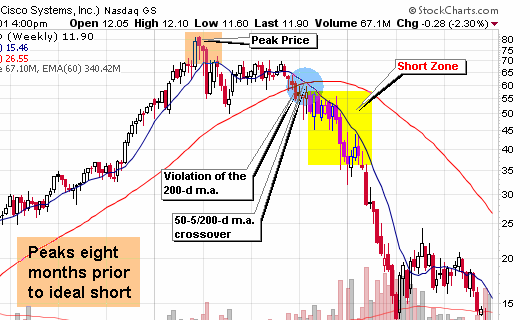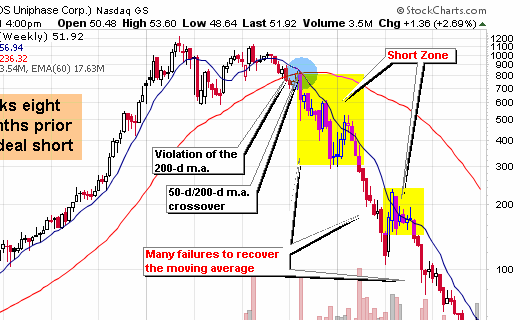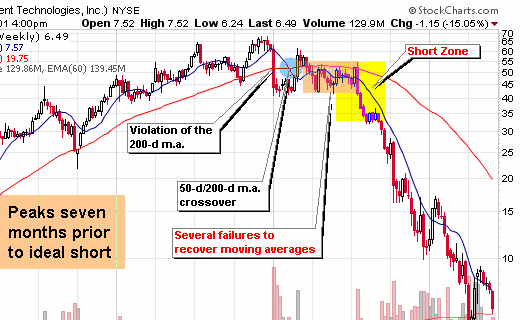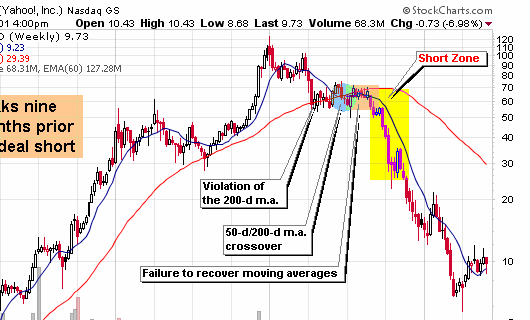The title of the post is borrowed from the book “How to make Money Selling Stocks Short” by William J. O’Neil. It’s an ideal book for investors that focus on trading longer term trends and don’t necessarily do this for a profession (i.e.: day traders).
The book contains some excellent strategies for finding prime shorting candidates or stocks that are about to enter a declining stage that may offer excellent risk/reward setups for buying put options.
I consider several of the techniques in the book to be a reverse of the popular trading system? Study the charts from the past that have setup ideal shorts and then screen for those same characteristics in stocks trading today. Many of the ideal shorts from past market declines have held the reverse characteristics of an ideal “popular system” stock (that you would want to buy).
Many traders believe that the most obvious area to place a short would be near the peak of stock’s trading range but studies have found this to be untrue.
Characteristics of Longer Term Trend Shorts
- Most ideal longer term “trend” shorts take four to twelve months after the peak price to setup on the weekly chart with the majority of these shorts triggering between six to nine months.
- Look for stocks that had prior up-trends and support levels that can now act as downward resistance or entry areas.
- Once a stock tops and starts to consolidate, you want it to slice through the 50-d moving average and then the 200-d moving average.
- A crossover between the 50-d m.a. and the 200-d m.a. is ideal and is graphically presented on each chart in this post
- The odds of success increase with each failed attempt for the stock price to recover these major long term moving averages.
- Head and shoulder tops can also serve as ideal setups for potential shorts if they take at least five months to develop.
- A decreasing relative strength line and a negative pattern on the point and figure chart can also confirm that the stock is rolling over and setting up an ideal short.
- Finally, volume should be increasing and the stock should be under distribution as it violates the major moving averages and starts to break former support levels.
No one knows when this market will roll over so study the ideal characteristics now so you are prepared to recognize them when they appear. I have (privately) screened several potential shorts over the past couple of months but this market is not ready to roll over just yet. I was early with my shorting analysis in 2006 so I do not want to make the same mistake in 2007. However, more and more stocks seem to be building bases like the ones from the bubble burst in late 1999 and early 2000 (examples in the charts provided). Until this market turns, I will not be posting up short candidates to the blog as I am not a market top predictor.
This bull could go on for another year – who’s to argue that? Do you have a crystal ball?
As the chart examples show, numerous shorting opportunities will appear giving the longer term trend trader adequate time to enter a position (no need to rush).
For further reading, see my two part article on shorting and the book by O’Neil – the charts alone are worth the price times 10!









Excellent and timely post, Chris, and highlighting two of my favorite books to boot.
Keep ’em coming…
-Bill
Bill,
“Timely post” — I am not trying to pick a top but I figured it is a good time to brush up on shorting skills. I just learned of the Mamis book last month. I wonder why I missed it all these years in searches.
Chris,
This might be a dumb question but I a very young in understanding the markets.
In the most extreme case, say a 1929 plunge, is one a guaranteed winner if you are shorting the market prior to its plunge? From a theoretical point of view, if the market completely collapses to the point where there are zero bids, zero asks, then having a short position is meaningless. Correct? For you to cover your short position someone must be “buying” from you? Right? I realize this is a very extreme case, but I was curious about the psychological effect of the market right after a devastating collapse.
Could it ever be so extreme, that literally no bid,ask exist and your short position means nothing, despite the market having having gone down?
Peter,
If the markets are going to crash completely: then nothing matters. Doubt that is going to happen. As a stocks drops, the market makers are required by law to buy the shares on the other end. When you cover, they must buy by law.
Markets can lock limit up or down where trading is suspended but they will reopen at a later date where buy and sell orders will be executed.